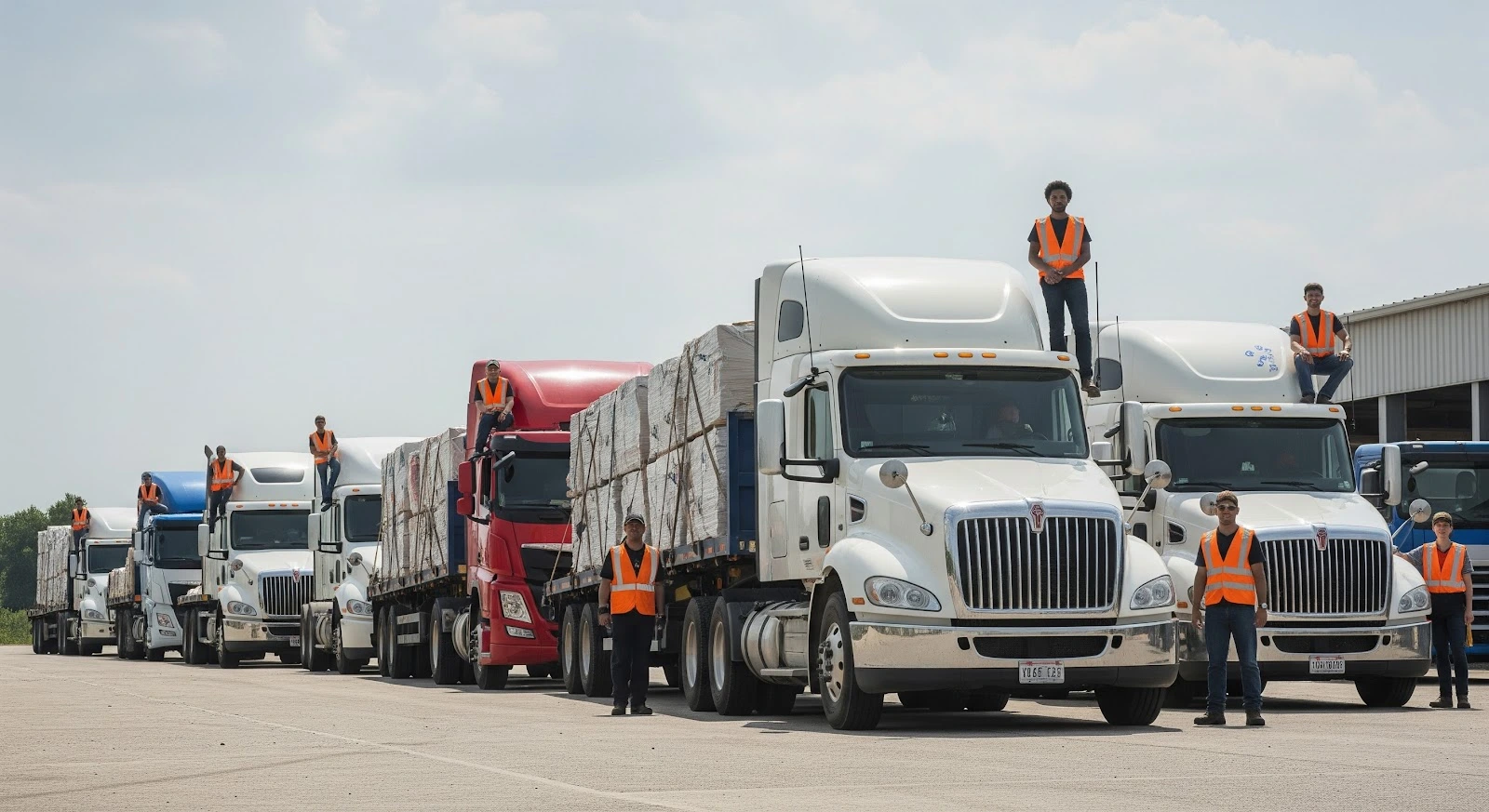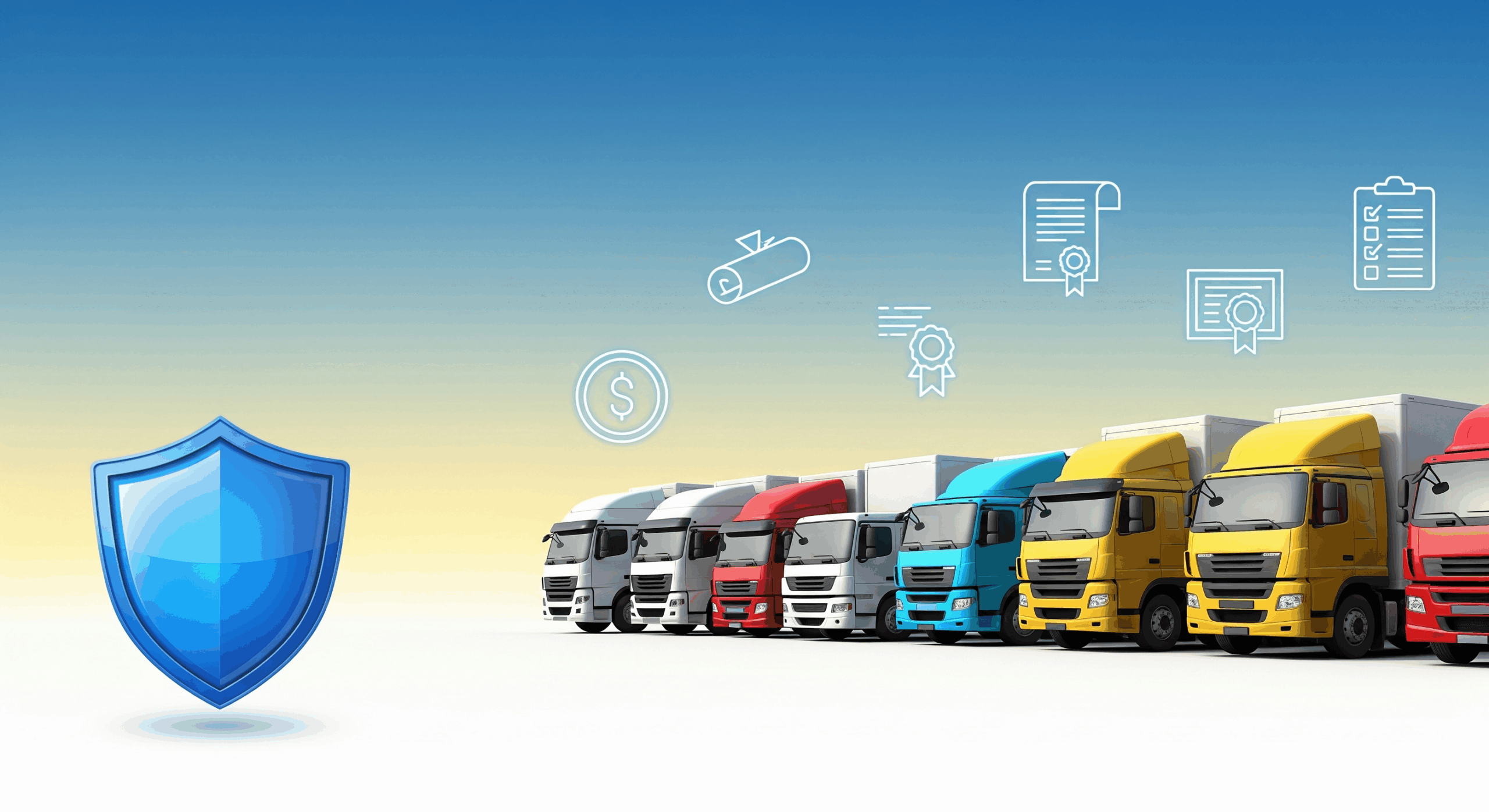For truckers—whether you’re an independent owner-operator, part of a small fleet, or just received your authority—knowing how to look for loads efficiently is one of the most important skills you can develop. Your ability to keep your truck moving with well-paying freight directly affects your cash flow, fuel usage, downtime, and overall business profitability.
With freight markets fluctuating and competition rising, simply having a truck isn’t enough. You need to be strategic and proactive in how you find and book loads. Choosing the right load at the right time and price can mean the difference between a profitable run and a money-losing trip.
This step-by-step guide will walk you through the most reliable and effective ways to search for loads—whether you’re just getting started or looking to sharpen your current process. From using load boards and freight apps to building broker relationships and negotiating better rates, this guide gives you a clear roadmap to stay loaded and stay profitable.
Step 1: Understand Your Trucking Niche
Before you can start looking for loads, it’s crucial to understand what type of freight you’re best equipped to haul. Your trucking niche not only defines the kind of equipment you use but also determines where and how you should search for loads.
Common Trucking Niches:
- Dry Van: One of the most common and versatile trailer types. Used to haul packaged goods, non-perishable items, and general freight.
- Reefer (Refrigerated): Designed for temperature-sensitive freight like produce, meat, or dairy. These loads often require stricter schedules and specialized maintenance.
- Flatbed: Used to transport oversized or oddly-shaped freight like machinery, lumber, steel coils, or construction materials. Requires knowledge of securement regulations and often involves manual labor.
- Hotshot: Typically run by pickup trucks with trailers. Ideal for expedited, lower-weight loads, often serving construction or oilfield industries.
- Tanker, Car Hauler, and Specialized: Other niche categories that may require additional endorsements or specialized equipment.
Why Knowing Your Niche Matters:
Each type of freight comes with its own load sources, seasonality, rate structures, and legal requirements. By clearly understanding your niche, you can:
- Focus on the right load boards and brokers.
- Build a reputation within a specific freight segment.
- Avoid wasting time on incompatible or low-paying loads.
- Position yourself as a specialist, which often commands higher rates.
Example:
Let’s say you’re running a flatbed. Your loads will likely involve construction equipment, steel beams, or oversized materials. In this case, general load boards may not be as effective as specialty platforms or direct relationships with flatbed brokers and construction companies. On the other hand, a dry van carrier will find more options on larger load boards and may benefit from building partnerships with consumer goods brokers or retail shippers.
By understanding your trucking niche from the start, you’ll make smarter decisions about where and how to look for loads—saving time, avoiding mismatches, and increasing your profitability right out of the gate.
Step 2: Set Up Your Business for Load Search
Before you can start booking loads, you need to ensure that your trucking business is properly set up and fully compliant with federal regulations. Most brokers and shippers won’t even consider working with you if you’re missing key documentation or your authority isn’t active.
Key Requirements to Have in Place:
- MC Number (Motor Carrier Authority): This is issued by the Federal Motor Carrier Safety Administration (FMCSA) and is required for hauling freight across state lines. Without it, you legally can’t operate as a for-hire carrier in interstate commerce.
- EIN (Employer Identification Number): The EIN is like a Social Security Number for your business and is required to file taxes, open a business bank account, and complete broker or factoring paperwork. It’s free and can be obtained from the IRS in minutes.
- Commercial Insurance: You must have the required level of liability insurance (typically $750,000 minimum for general freight) and often cargo insurance (usually $100,000). Brokers and shippers will verify your insurance coverage before offering you loads.
Why Compliance Matters:
If your business isn’t properly set up, you could:
- Be rejected by brokers who run carrier vetting checks.
- Miss out on high-paying loads that require fast paperwork turnaround.
- Risk penalties for operating without authority or proper coverage.
Being compliant makes you a reliable option for brokers, dispatchers, and direct shippers. It gives them confidence that you’re ready and able to move freight legally and professionally.
Optional (But Helpful) Tools to Improve Load Access:
- DOT Number: Required for most commercial vehicles operating in the U.S., especially if crossing state lines. It tracks your safety record and is often used by brokers to review your standing.
- Freight Factoring Company: Factoring helps you get paid faster—typically within 24 hours—by buying your freight bills at a discount. Some factoring companies offer access to exclusive load boards or broker networks, giving you more load options.
- GPS Tracking and ELD Systems: Many brokers prefer carriers with real-time tracking capabilities for freight visibility. ELDs (Electronic Logging Devices) are also required by FMCSA for Hours of Service compliance and may be integrated with GPS for more efficient operations.
By taking the time to set up your business properly, you’ll not only meet federal requirements—you’ll also become far more attractive to brokers, shippers, and factoring companies that can keep your truck consistently loaded.
Step 3: Use Load Boards
Once your trucking business is properly set up, the next step is to find paying freight—and one of the most popular ways to do that is through load boards.
What Are Load Boards and How Do They Work?
Load boards are online freight marketplaces where shippers, brokers, and carriers connect. Brokers and shippers post available loads, and truckers or dispatchers can search for freight that matches their equipment, location, and availability.
You can filter loads based on:
- Pickup and delivery location
- Trailer type (e.g., dry van, reefer, flatbed)
- Load weight
- Pay rate
- Date and time
Once you find a load you’re interested in, you contact the broker directly through the platform or via phone to negotiate and book the load.
Best Load Boards for Truckers
Here are some of the most trusted and widely used load boards in the industry:
DAT Load Board
- The largest and most popular load board in the U.S.
- Offers real-time updates, average lane rates, and broker credit scores.
- Great for all types of carriers, especially those looking to negotiate better rates.
- Subscription-based, but highly recommended for serious operators.
TruckStop.com
- Known for its wide variety of freight and trusted broker network.
- Offers tools like rate insights, fuel management, and broker reviews.
- Good for both beginners and experienced truckers.
- Offers free trial and tiered paid plans.
123LoadBoard
- Affordable and user-friendly, especially for owner-operators.
- Offers credit scores, mileage calculators, and mobile app access.
- Has both free and premium paid options.
Direct Freight
- Easy-to-use interface with real-time load tracking.
- Email alerts and detailed load filtering available.
- More budget-friendly than others with a free trial and low-cost plans.
Free vs. Paid Load Boards: Which Is Right for You?
- Free Load Boards: Good for getting started, but often have limited listings and lower-paying freight. You may face more competition and fewer search filters.
- Paid Load Boards: Offer more features, better-paying freight, and real-time data. They’re ideal for serious operators looking to stay loaded consistently and make smart decisions based on rate trends.
Think of a paid load board as an investment. The right subscription can pay for itself in just one or two well-paying loads.
Tips for Reading Load Board Listings Effectively
- Pay Attention to Rate per Mile (RPM): Divide total pay by loaded miles to make sure the rate covers your operating costs.
- Check Broker Credit Score: Most boards display broker reliability ratings—avoid those with poor payment histories.
- Understand Deadhead Miles: Always calculate the miles you’ll travel empty before pickup—this affects profitability.
- Watch for Load Details: Read the full listing for special requirements like tarp, team driver, or time-sensitive delivery.
- Call Quickly & Professionally: Loads can disappear fast. Be prompt, polite, and ready to ask key questions about the load.
By using load boards strategically and reading listings carefully, you can keep your truck moving and avoid costly downtime. As you gain experience, you’ll learn which platforms and brokers offer the best opportunities for your specific niche.
Step 4: Build Broker & Dispatcher Relationships
While load boards are a great starting point, building strong relationships with freight brokers and dispatchers can lead to more consistent, higher-paying loads—especially as you gain experience and credibility in the industry.
Finding Reliable Freight Brokers
Freight brokers act as the middlemen between shippers and carriers. A good broker can become a long-term source of loads, helping you stay on profitable lanes and avoid empty miles.
Here’s how to find quality brokers:
- Start with load boards: Many loads list broker names and contact info. After hauling a few loads successfully, start nurturing those relationships.
- Use freight broker directories: Services like DAT, TruckStop, or Internet Truckstop offer directories with broker contact information and reviews.
- Network at truck stops, industry events, or online forums: Word of mouth goes a long way in the trucking world.
Verifying Broker Credentials
Before working with a new broker, do your due diligence to ensure they are legitimate and trustworthy.
Check the following:
- FMCSA Registration: Visit the FMCSA website and enter the broker’s MC number or name to confirm their authority status and safety record.
- Broker Bond (Surety Bond): All brokers are required to have a $75,000 surety bond to ensure payment. You can verify this through FMCSA or your factoring company.
- Credit Checks: Use load boards or factoring services to check the broker’s payment history. Avoid brokers with poor credit or histories of delayed payments.
- Reviews and Ratings: Check online forums, load board feedback, and industry groups to see how other carriers rate their experiences.

How Dispatchers Can Help New Truckers Stay Loaded
Dispatchers are independent professionals or agencies that find, negotiate, and book loads on your behalf. This can be especially helpful if you’re new to the industry, busy driving, or don’t yet have broker connections.
Benefits of working with a dispatcher:
- They handle paperwork, rate negotiation, and scheduling.
- They monitor multiple load boards for you.
- They can help keep your truck moving without gaps in freight.
Dispatchers typically charge a percentage of your gross rate—usually between 5–10%.
Pros and Cons of Working with Dispatchers
Pros:
- Saves time and effort finding loads
- Helps maximize weekly revenue
- Can assist with billing, paperwork, and compliance
- Often have established broker contacts
Cons:
- Costs you a cut of your revenue (e.g., $200–$300+ per load)
- Quality varies—some are unreliable or inexperienced
- Less control over which loads you take if they’re booking everything
If you choose to work with a dispatcher, vet them just like a broker. Ask for references, check reviews, and understand their fee structure and responsibilities before signing any agreement.
Building relationships with brokers and dispatchers is an important step in growing your trucking business. Over time, these partnerships can lead to dedicated lanes, better rates, and a steady flow of freight that minimizes downtime and boosts profitability.
Step 5: Work With Freight Factoring Companies
Running a trucking business means dealing with tight cash flow—especially when brokers take 30 to 60 days to pay. That’s where freight factoring companies come in. They help you get paid faster so you can keep rolling without worrying about fuel, repairs, or payroll.
What Is Freight Factoring and Why It Matters?
Freight factoring is a financial service that buys your unpaid freight invoices at a small discount—usually around 2% to 5%—and pays you the majority of the load amount within 24 hours.
Here’s how it works:
- You deliver a load and submit the invoice and proof of delivery (POD) to the factoring company.
- They advance you most of the payment upfront—often 90–97%.
- Once the broker pays the invoice in full (usually in 30-45 days), the factoring company gives you the remainder, minus their fee.
Why It Matters:
- Fast Cash Flow: Get paid quickly so you can cover fuel, maintenance, tolls, and driver pay without delays.
- No More Waiting on Brokers: Eliminate stress about long payment terms or slow-paying clients.
- Credit Risk Protection: Many factoring companies check the broker’s credit before you haul, helping you avoid non-payment issues.
How Factoring Can Give You Access to Better Loads
Factoring isn’t just about faster pay—it can open doors to higher-quality loads too:
- Broker Recommendations: Factoring companies often maintain lists of approved brokers with good payment histories. This helps you focus on reliable clients and avoid financial risk.
- Stronger Negotiating Power: When you’re not worried about cash flow, you can be more selective with loads, lanes, and rates.
- Load Board Integrations: Many factoring companies partner with load boards like DAT or TruckStop to highlight pre-approved loads from brokers they already trust.
Integrations with Load Boards and Quick Pay Options
Leading factoring companies offer integrations that make life easier for truckers:
- Integrated Search: See which loads are “factorable” right on your load board dashboard.
- Quick Pay Options: Some factoring companies offer same-day pay or fuel advances, helping you cover costs while you’re still on the road.
- Back-office Support: Many factoring plans include free services like invoicing, collections, and document scanning apps—saving you time and admin hassle.
Some factoring companies also provide:
- Fuel cards with discounts
- TMS (Trucking Management System) software
- Fleet growth consulting
Pro Tip: Make sure to read the terms carefully before signing with a factoring company. Look out for long-term contracts, minimum volume requirements, or hidden fees. Non-recourse factoring (where the factor takes on the risk of non-payment) is safer but may cost a bit more.
Working with a reputable freight factoring company can significantly improve your cash flow, reduce stress, and help you grow your business faster—especially when combined with smart load board strategies and solid broker relationships.
Step 6: Stay Consistent and Keep Records
Finding good loads is only half the battle—keeping track of your operations and maintaining consistency is what helps you build long-term success in the trucking industry. The most successful truckers treat their work like a business, not just a job.
Track Your Load History, Broker Contacts, and Rate Agreements
Every load you haul gives you valuable data—don’t let that information go to waste.
Here’s what you should track:
- Load details: pickup/drop-off dates, weight, commodity type, and lane.
- Broker/shipping contacts: names, phone numbers, email addresses, and payment terms.
- Rate confirmations: total rate, rate per mile, fuel surcharges, accessorial charges.
- Payment history: invoice date, payment date, factoring details (if applicable).
Why it matters:
- Helps you identify which lanes and brokers are the most profitable.
- Makes it easier to resolve disputes or delayed payments.
- Allows you to compare seasonal trends and negotiate better rates in the future.
- Builds a personal database of trusted brokers to call when you need a load.
Use TMS (Trucking Management Software) or Spreadsheets
Staying organized doesn’t require a fancy system, but it does require consistency.
Two options:
TMS (Trucking Management Software):
- Tools like TruckLogics, Axon, Tailwind, or Samsara offer:
- Load tracking
- Invoice generation
- Expense reports
- Fuel tracking
- Maintenance schedules
- Load tracking
- These tools save time, reduce paperwork errors, and keep your entire operation running smoothly—even if you manage multiple trucks.
Spreadsheets (Low-Cost Alternative):
- If you’re just starting out, a well-organized Excel or Google Sheets file can work too.
- Set up columns for:
- Load date
- Pickup/delivery
- Broker name/contact
- Pay rate
- Miles driven
- Fuel cost
- Invoice status
- Load date
Regardless of the tool you use, keeping accurate records helps you make smarter business decisions and stay compliant during audits or tax time.
Improve Repeat Business Through Professionalism and Reliability
Repeat business is key to building a sustainable trucking operation—and that starts with being dependable.
Here’s how to stand out to brokers and shippers:
- Be on time for pickups and deliveries.
- Communicate clearly if you’re delayed or need to reschedule.
- Submit paperwork promptly after delivery (rate confirmation, POD, invoice).
- Maintain a clean safety record—brokers check this before assigning freight.
- Follow up with brokers you’ve worked with before. A simple call or email can lead to repeat loads or even dedicated lanes.
When brokers trust you, they’ll offer loads directly—sometimes even before posting them publicly. That means less competition, better rates, and more consistent work.
By staying organized, documenting your work, and operating professionally, you’ll move beyond load boards and into long-term, profitable relationships that keep your wheels turning year-round.



